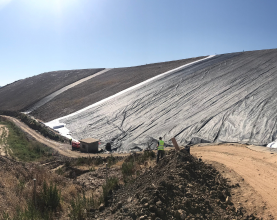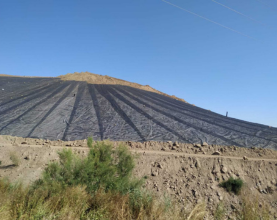How does landfill capping work?
Today, globally, waste management is one of the biggest problems facing urban governments. With the increasing consumption rate of goods and the manufacturing of those goods, a significant amount of waste is generated. When not managed properly, this waste can be hazardous to health and cause irreversible health issues. To combat this issue, landfills are created to dump the waste without it coming in contact with people. However, a key challenge is that most landfills were created outside the perimeters of human dwelling and today they’re part of the urban landscape within city limits. As a result, the risks that come with contamination are much higher than the decades prior.
Landfills are man-made sites on open grounds that can hold tonnes of waste below the land surface. A protective capping layer is installed to prevent waste contamination from penetrating the soil. In this blog, we will learn the role of landfill capping in waste management, examining its significance and how it can contribute to a healthier environment.
Understanding landfill capping
Landfill capping installed above the waste in a landfill, acts as a strong barrier against environmental contamination. It prevents harmful substances from seeping into the soil or groundwater; thereby protecting ecosystems and public health. These covers, also known as caps, play a crucial role in isolate waste, preventing the spread of contaminants to the surface and limiting exposure to humans and wildlife.
Historically, natural materials such as clay, gravel, and sand were used to prevent contaminants from polluting water and soil. However, as waste became more complex and hazardous, these traditional methods proved insufficient. The high cost of procuring such materials led to the search for more efficient alternatives. This need drove the development of advanced landfill capping technologies, with modern solutions like geosynthetics taking center stage.
Types of landfills and their capping
Landfills are categorized into four types based on the type of waste they handle: municipal solid waste, industrial waste, hazardous waste, and green waste. Each category requires distinct disposal practices for safe and controlled waste management.
a. MSW (Municipal Solid Waste) landfills:
Municipal solid waste comprises waste generated in general households. This can include wet waste (generated in the kitchen) and dry waste (wrappers, cardboard, tissues, paper, etc.). MSW landfills are monitored with strict rules and regulations. These regulations include selecting landfill sites, operating practices, capping measures, and level of contamination penetration. This type of landfill is enclosed in four layers: geosynthetic capping, drainage system, gas collecting chamber, and waste. Every layer is closely monitored to prevent environmental contamination.
b. Industrial waste landfills:
Industrial landfills primarily contain construction and demolition (C&D) debris such as concrete and rubble, hence their common name; C&D landfills. The waste brought into these landfills is not disposed of at first. The waste is sorted into two categories: reusable materials and waste material. Reusable materials are resold to local buyers or businesses, while the remaining waste is safely disposed of under controlled conditions.
c. Hazardous waste landfills:
These landfills are specially engineered to contain hazardous waste materials such as batteries, corrosive metals, toxic chemicals, crude waste, and pesticides. Hazardous waste landfills are designed to virtually remove the chances of contaminants being released into the environment. They feature multiple protective layers, including dual impermeable caps, a double leachate collection system, a gas collection system, and the waste containment layer. In addition, the landfills undergo rigorous checkups and yearly maintenance with strict monitoring regulations.

d. Green waste landfills:
As the name implies, green waste landfills are designated for storing organic materials such as yard trimmings, food scraps, and other biodegradable waste. The waste stored in these landfills generates organic compost through decomposition. These are often composting facilities, and while not typically regulated as strictly as MSW or hazardous landfills, they still follow environmental guidelines. They play a significant role in multiple ways. Such as:
- Reducing the burden on municipal solid waste landfills.
- Producing organic compost that can be used as natural fertilizer.
Click here for details on types of landfills and their expansion process.
Application of Strata’s geosynthetic products in landfill construction
Strata Geosystems has always been a pioneer in providing the best geosynthetic materials. We offer products that can be applied in landfill construction.
From reinforced steep slopes and site perimeter haul roads to retaining walls and other infrastructure, Strata’s structural geosynthetic products provide stability, longevity, durability and structure even on the weakest subgrades. Our products allow you to construct over soft and fragile subsoils with MSE berms, veneer stability and landfill caps.
a. MSE berms:
Strata Geosystems supplies specially designed MSE (Mechanically Stabilised Earth) berms. These berms use best in class geogrids and soil to build a grade separation that lets the landfills expand vertically as and when they need more space.
b. Veneer stability:
Our geosynthetic products provide veneer stability for linear support in landfills. In some cases, soil alone cannot bear the load of the landfill structure. In such cases, veneer stability is provided by geomaterials to provide more stability and ensure a robust foundation.
c. Landfill caps:
The landfill capping system provided by Strata Geosystems comprises geosynthetic products used in a series of layers, that act as a protective mechanism. These layers prevent contaminants and moisture from seeping into the subsoil.
Landfill drainage solutions by Strata Geosystems
Our products offer landfill drainage solutions to ensure the site remains safe, and can be monitored. Here’s how:
Leachate collection:
Throughout a landfill, the waste produces harmful contaminants, also known as leachate, which is collected at the base. This harmful collection of gases and liquids requires proper disposal as it may contaminate the surroundings. For this process, the proper drainage system, which consists of StrataDrain (geocomposite drain) and drainage pipes, is installed at the landfill’s base.
Furthermore, a double- or single-liner drainage system is installed depending on the type of waste collected in the landfill and the groundwater level. The drainage liner system comprises a geomembrane, StrataDrain, and geotextile layer. StrataDrain allows the leachate to flow out through the installed drainage system.
Usually, two layers of StrataDrain are installed. The first layer is used for draining out the leachate, and the second layer, installed above the first layer, works as a leak detector. If there is a leak in the first layer, the second layer works as a backup drainage system and detects the leakage. It then allows the collected leachate to flow through it and pass through the drainage system for proper disposal.
Capping solution:
Rainwater accumulated over the landfill’s closed surface area must be collected and properly channeled to the drainage area. Another important aspect of capping is gas and leachate collection. The gasses generated within the waste collected should be ventilated safely. These gasses are disposed of using pipes and chimneys.
Traditionally, a thick layer of aggregates ranging from 300 to 600 mm was used for efficient gas drainage into collection systems and rainwater drainage to underground water collection systems. Ever since geomaterials were introduced, they have effectively replaced the aggregate layers. Using StrataDrain will effectively remove the requirement for conventional materials like aggregates, ultimately reducing carbon footprint, providing more storage capacity, and decreasing costs.
Benefits of using Strata’s geosynthetics for landfill capping
While easy installation and cost-efficiency are key advantages of StrataDrain, the material offers several other significant benefits for landfill capping:
- Using StrataDrain for landfill capping provides a protective layer. It prevents harmful gasses, leachate, and contaminants from penetrating the groundwater.
- Gases collected within the landfill can be harnessed to generate renewable energy.
- It is environmentally safe as its properties reduce carbon footprints and are long-lasting.
- It also traps foul odors and decomposition gases, thereby reducing air pollution.
- Since the geomaterials by Strata Geosystems are made of polymer material, they effectively conserve natural materials such as sand, gravel, and soil.
- StrataDrain is also more cost-effective than conventional natural materials.
- Another key advantage is its adaptability, it can be easily installed on any slope, reducing construction time and accelerating project completion.
- Geosynthetic layers take up less space than traditional materials, which typically require up to 600 mm of thickness. This slimmer profile increases the available storage capacity within the landfill.
- StrataDrain’s longevity and robustness are much greater than any other landfill capping material. Hence, it provides better structural stability and durability.
Geosynthetic solutions for landfill capping
Strata implemented its geosynthetic solutions in the Surface Sealing and Post-Closure Maintenance project at the Villena Municipal Solid Waste (MSW) Treatment Plant Landfill. The project required a careful capping approach with strict consideration for environmental protection.
Scope of work
Strata provided rainwater drainage and gas collection solutions using the StrataDrain geocomposite system. Additionally, steep side slopes were reinforced using another of Strata’s innovative products like StrataGrid.
Key challenges
A major technical issue involved designing an anchor trench to fit within a highly constricted space. To solve this, we developed a tailored installation methodology specific to the project requirements and solved the issue of the extremely constricted space. The landfill needed some adjustable solutions due to its intricate topography and we managed to adjust their geosynthetic solutions for this terrain as per requirement.
Solutions provided by Strata
Our solution including our high quality products delivered better outcomes compared to a conventional approach using gravel and ordinary geotextiles.
- High flow rate: StrataDrain allowed high flow rates and thus improved the efficiency of the rainwater and leachate management.
- Improved design efficiency: New design by us ensured improved performance along with increased reliability.
- Reduced overloads and increased security: The structural load was reduced by StrataDrain and StrataGrid together with security. This added to the overall cost-effectiveness.
Project outcome
Strata successfully adapted its geosynthetic solutions to the complex terrain of the Villena landfill, demonstrating expertise in environmental engineering and delivering a secure, eco-friendly closure solution that met client requirements.

StrataDrain has significantly upgraded the landfill construction by providing durability, stability and longevity to the structure. With its high tensile strength and cost-effectiveness, this geocomposite offers an economical alternative to traditional materials, contact us today!
